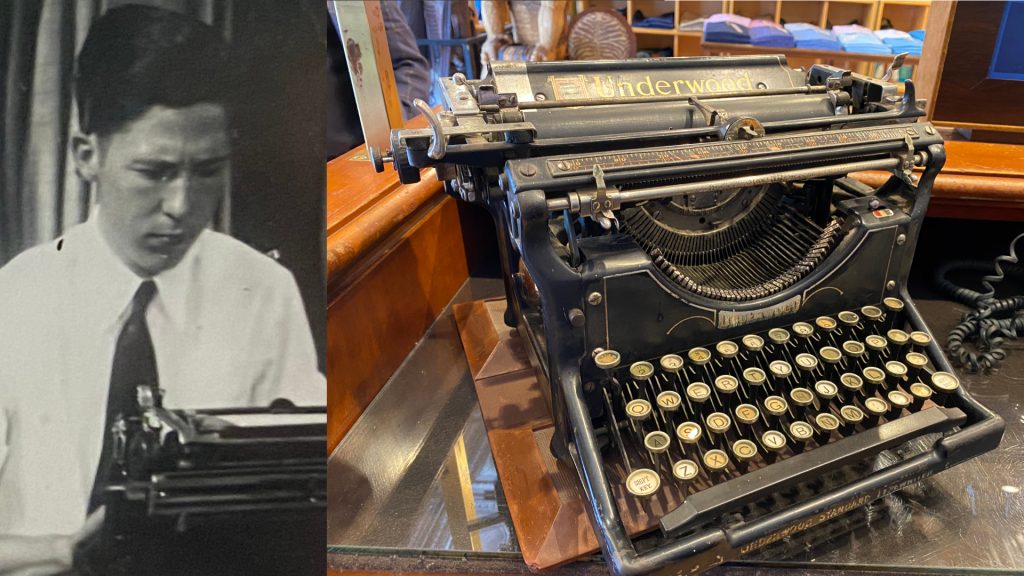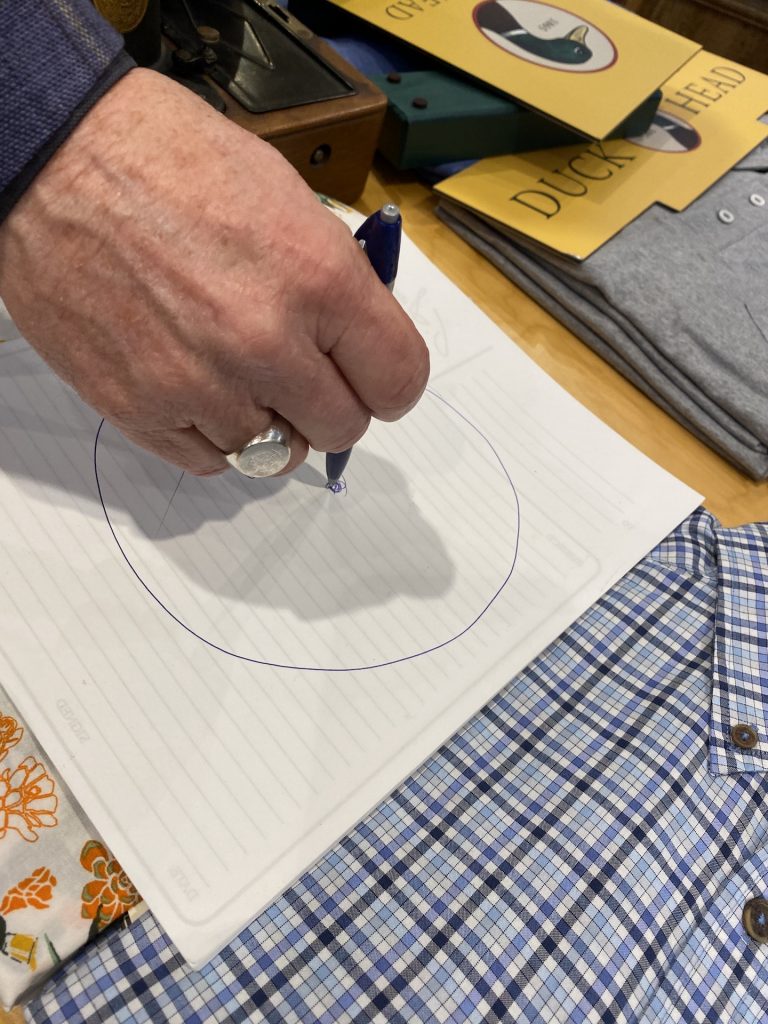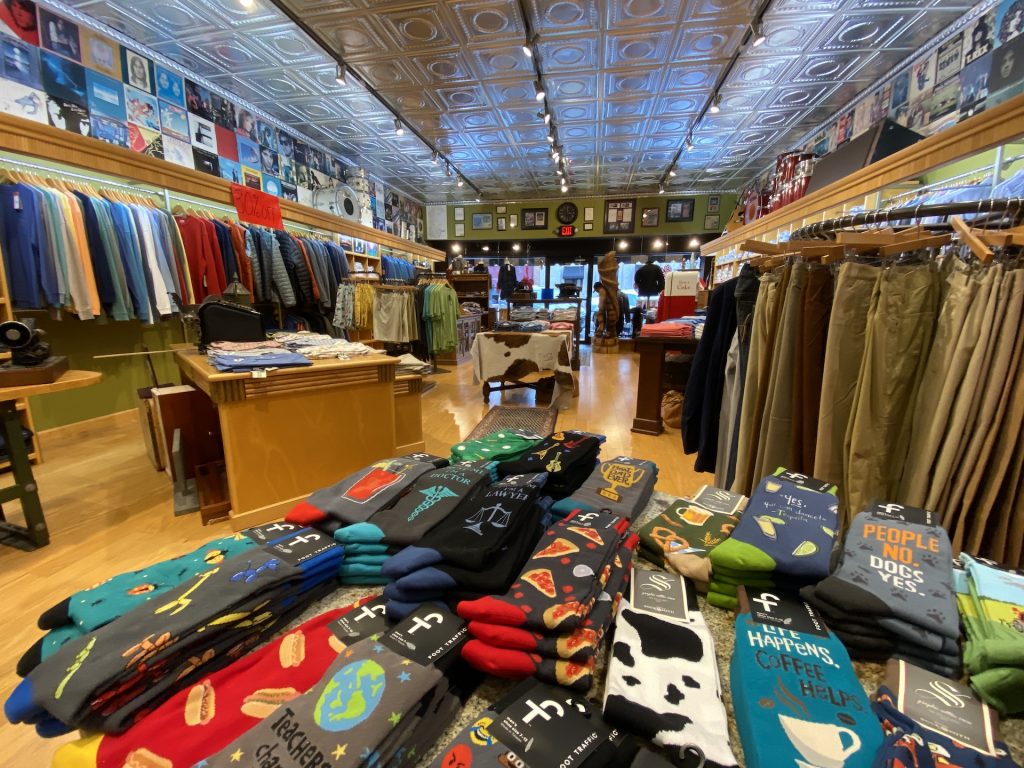A winter morning in New Albany, Mississippi. The sun rises above the brick buildings on the eastern end of Bankhead Street. Shoppers and delivery trucks park smack dab in the middle of the town’s central thoroughfare. And from speakers concealed beneath the awnings of a building on the far edge of downtown comes the sound of Billy Joel belting out “Piano Man,” Mick Jagger chewing his way through “Start Me Up,” and David Bowie’s alien alto bleating the lyrics to “Changes.”
This store, built as the First National Bank back in 1890, is what well-dressed locals call Sappington’s, though the formal name, emblazoned on an oval sign hanging above the doors, is T. Sappington and Company.

Just inside the door — behind a display window featuring puffy jackets, golf clubs, and the American flag — stands a serpentine gargoyle more than seven feet tall and carved out of a single block of wood.

Today, he sports a jaunty blue denim cap and holds a leather camera case; a couple of months ago, festive lights draped his sculpted wooden shoulders.
Follow the curves of his upraised wings to the gleaming pressed aluminum ceiling. Had you walked into this building to make a bank deposit in 1890, you would have seen these very same tiles … but you would not be seeing them today had they not been painstakingly restored and reinstalled by the shop’s owner, Tommy Sappington. Tommy also acquired and installed the ornate metal cornices, hung the track lighting, and installed and finished the hardwood floors.
The music that lured you in has a source: Tommy’s collection of vintage vinyl, often spinning on antique turntables concealed in the back of the shop. The covers (along with record sleeves donated by friends and customers) line the upper edges of the store’s eastern and western walls: Rod Stewart’s Atlantic Crossing, Elton John’s Rock of the Westies, Al Stewart’s Year of the Cat, Peter Frampton’s I’m in You, Kenny Loggins’ Keep the Fire. (Donna Summers appears, too, but Tommy “definitely disowns the disco.”)
Displayed along with these on shelves high above the retail floor: drum sets, cymbals, guitars, accordions. This infusion of music is perhaps why Tommy describes himself not so much as the store’s owner, but as its “singer/songwriter.”

This is a modest claim, as Tommy and his wife, Martha Carolyn, are also the store’s saviors — and two of a handful of people who, over the last several decades, through sheer determination and grit, have kept both this shop and New Albany’s Bankhead Street alive.
Birth of a Family Business
Despite the music pulsing through its veins, T. Sappington and Company is — and always has been, since opening in 1956 — a clothing store. Push aside the neatly folded stacks of Peter Millar shirts, 7 jeans, Barbour vests, and wildly patterned socks, and you’ll see, beneath protective glass, original black and white photos of Tommy’s father, Roy Harold Sappington.
One photo shows the shotgun house (named for the fact you could stand at the front door and fire a shotgun straight through to the back) where Roy Harold was born. “It was a plank house,” Tommy explains, “sitting on some type of block, with construction, a tin roof, and the porch falling off it. There was a fireplace for heat with no electricity, and a smokehouse and an outhouse outside.”
In another photo, dated 1945, twenty-three year-old Roy Harold (a petite man with slicked-down hair, a crisp white shirt, narrow tie, and long-legged trousers) poses in front of a bulbous Oldsmobile. Another shows him giving a chaste peck on the cheek to a woman with a Donna Reed hairstyle, a knee-length dress, crisp white bobby socks, and sensible shoes — Tommy’s mother. Yet another shows him working at an Underwood typewriter Tommy keeps in the store to this day.

Back home after flying bombing runs in World War II, Roy Harold took a job at Winburn Simmon’s clothing store — one of the many merchants (clothiers, shoe stores, multiple pharmacies stores, grocery stores, soda fountains, and even a car showroom) lining Bankhead Street. Within a few years, he owned twenty percent of Simmon’s business; by 1956, “seeing an opportunity to sell clothing to people who worked for a living,” he opened a midrange store of his own in a building just twenty feet wide.
The business thrived, in part because Roy Harold was a consummate salesman. Tommy recalls a time an older woman came to try on a pantsuit. “My dad was helping this woman in the dressing room, and she broke the zipper on her trousers. So she opened the door, looked right at my father, and said, ‘There’s not any men in here are there?’ Dad kind of blinked and looked at her and said, ‘No, it’s just me.’
The older woman looked right at my father and said, “There’s not any men in here are there?”
Dad said, “No, just me.”
“So he took a pair of scissors and cut the zipper out … and the beauty of it was that he sold her those pants after cutting her out of them! That’s how good a salesman he was.”
Tommy was just two years old when his parents opened their business, and he started working at Sappington’s and Company just five years later. “I was going to market with my parents — this rundown place with terrible exposed pipes and elevators without doors. At ten, I was making boxes for people — gift wrapping and things — but I was encouraged even then to go to market and learn the trade.”
With time, Tommy went to work on the retail floor, but Roy Howard didn’t care for Tommy’s salesmanship. “He said, ‘You’re the worst salesman I’ve ever seen in my life! You’re just an order-taker! Somebody hands you something you ring it up! You need to sell them something else!’ I told him that, instead of me being pushy, if my customers needed something else, they could ask me to help them find it.”
Despite these differences in approach, the younger Sappington eventually worked his way up to owning half the business, and, after a heart attack prompted his father to retire, ownership of Sappington’s passed entirely to Tommy. “It was expected of me to take over,” Tommy admits. “And I’ve always been relatively good at this. What you like about the situation is the people: they come in, they’re pleasant, and you just try to help them, to be honest with them. You give them a good product at a good price.”
With an established brand drawing a faithful clientele on a small town’s thriving main street, Tommy and his wife, Martha Carolyn, seemed positioned for a lifetime of success. They built a home together. They started a family.
“Business was wonderful,” Tommy tells me. “Until it wasn’t.”
The Massacre at Barnes Crossing
Like his father, Tommy Sappington is a compact person: a petite, tightly-wound dynamo of energy. He perches on a chair to talk with me; within fifteen minutes, he gets up five times: adjusting thermostats, rummaging for photographs, adjusting a display, chasing down a stray bracelet on the floor.
“I’m on 100% all the time,” he says. “I have to be. I’m vacuuming and stocking and doing everything. I mean, it’s not like I’m selling real estate or Ferraris. But I want people to know how much I appreciate them doing business with me.”
This appreciation springs, in part, from having survived a long stretch in New Albany’s history when customers weren’t streaming through the doors. Or walking the streets. Or coming to downtown. One by one, the pharmacies and shoe stores and gift shops and grocers closed up shop. Where commerce once thrived, aluminum awnings drooped and brickwork crumbled. Soon, Bankhead Street was deserted, with the exception of two stores: Van Atkins Jewelry and Sappington’s.
Business was wonderful — until it wasn’t.
What force transformed a vibrant downtown into a ghost town? In 1991, in nearby Tupelo, Mississippi, the Mall at Barnes Crossing opened. “It was instant,” Tommy says. He sits back in his chair, exhales heavily, and runs his hands over his face. “The minute they unlocked the door, our sales fell by half. It was not a slide. It was…” He pantomimes an explosion. “Boom!”
Worse, this grim reality didn’t exactly come as a surprise. “Before they opened, these men came here and they drew us a little illustration.” Tommy snatches a scrap of paper, produces a pen, puts a dot in the center of the page (“That’s the mall!”) and draws a circle around it.

“They told us we had two options: move into the mall or shut down. Barnes Crossing would absolutely destroy retail in a sixty-mile circle around it. And it did. Seventy percent of the people who do what I do for a living were out of business in just a matter of a few years. Everybody else was doing well … but for the retail sector, it was absolute terror.”
Faced with losing their business and their new home, Tommy and Martha Carolyn went into survival mode. “We were sitting there at home wondering what we could do to supplement our income. We had a four year old and a six year old. We were trying to raise children, and we had one income and it was terrible at best.
“So I started woodworking three nights a week. I would leave at 9:00 when the kids went to bed, and I would come down at my shop and work until two or three in the morning, making things to sell. People talked about my woodworking as a hobby, and that really irritates me, because a hobby is something you do for leisure or enjoyment. But in this case, money that should have been fun money was going back into this business to keep it alive or to keep us in our home. That was literally working a second job. But I never gave up on my day job, because I was smart enough to know that one or the other was not going to do. I took both.”
Banding together to Save Bankhead Street
Throughout our conversation, customers come and go. Martha Carolyn wanders up front to help a woman shopping for sports coats; Tommy recognizes the customer and shouts, “Her husband’s a 42 long!”
Another visitor, an older gentleman with close-cropped gray hair, sticks his head in the door, waves, and saunters off down Bankhead Street. “That man right there,” Tommy says. “Billy Wiseman. He basically saved downtown New Albany and the historic district.”
In 1996, Wiseman led Tommy and others to join the Main Street Association. “It taught you how to promote your community. And a lot of us in our forties and fifties started buying up downtown buildings, essentially for land value. There was nothing usable in the buildings. And that was the turning point … local people started investing. There was zero government aid … just sweat equity. We said ‘We’re going to be tenacious. We’re going to fix this.’”
The clever trick — what seemed to turn the tide and bring business back to Bankhead Street — was inverting the renovation process. ‘Rather than buy a building and redo the inside and then do the outside, we reversed it. We fixed the outside first and made it attractive, and then we started working on the interior of the building. It was almost the reverse of what most people would think of doing.”
Even as Tommy and others worked hard — tearing down aluminum awnings, painting lampposts by hand — some locals opposed the changes. “It’s the 80/20 principle,” Tommy notes. “It’s a national statistic. When you start the Main Street program, twenty percent of the people are four you, and eighty percent are against it. And when it works — as it did in Franklin, Tennessee, the first Main Street city — you turn a corner, and then suddenly eighty percent of the people are for you and twenty percent are against you. So: it just flip-flops.”
And, as merchants banded together, downtown began coming back to life. “You had the Bank of New Albany. You had people like Chuck Cooper (of Van Atkins Jewelers) that started bringing people here from all over the South — even from all over the United States — to buy estate jewelry. And then there was Mary Jennifer Russell, this brilliant business woman who went from baking cakes from scratch at home to a bakery shipping things all over the country and ending up on Oprah’s list of must-have Christmas gifts.”
Reinventing the Family Business
Bankhead Street coming back to life was one thing; Sappington’s survival was another … and that required rethinking the store’s mission from the ground up. “Once, we were the inexpensive store in town. We sold Levi’s and Bugle Boy shirts and brands nobody’s ever heard of. They were very reasonable. But the world changed. Walmart sells those things to people every day.
“People give me credit for realizing this, but It was actually my wife, Martha Carolyn, who said, ‘If we’re going to stay in business, we’ve got to go to another level.’ The kids were old enough, so she came to work and it immediately changed what this was. I didn’t fix it, and when I tell people that, they say, ‘Yeah, go on.’ But trust me: I was here. She has a different way of thinking about things. She does all the computer work and the social media and the Instagram account. She basically saved a dying business.

“And I resisted, because it wasn’t my comfort zone to sell Peter Millar, David Donahue, Barber, A.G. Jean, Citizens of Humanity, 7 Jeans. I didn’t grow up wearing those clothes, but to stay in business, we had to start giving people a premium product.
“We’re in a small town, so we provide a lot of service. I do all the alterations, usually while you wait. We’re trying to give people what they expect in Oxford or Memphis or Tupelo in a tiny little town — not at that scale, but a little taste, a sampling of that. Running a shop like this in a town this size … well, everybody knows about the kind of business you conduct and the kind of stuff you have in place. So you have to be more than a proprietor. You have to be an ambassador.”
Proud Locals: The Lifeblood Keeping Downtown Alive
Today, on a midweek morning, Bankhead Street bustles. Shoppers file in and out of Sappington’s. A mother and her daughter, wearing matching hair bows, sample chocolate oatmeal drop cookies at Sugaree’s. An older woman leaves Van Atkins Jewelers with a package in hand. Someone stops me on the sidewalk and asks if I know what the lunch specials are at Tallahatchie Gourmet.
This kind of small town success is surprising … and fragile. The bloom is off the rose at the Mall at Barnes Crossing, but new threats to New Albany’s thriving business district emerge every day. Amazon offers fast delivery and low prices; Tommy tries to compete by offering a level of personal service (providing free alterations, knowing his customers’ sizes and tastes) online retailers can’t match. Many shoppers now prefer to spend more on personal technology than on clothing; Tommy counters this by trying to carry a range of products and a little something for everyone.
“You can drop someone off at any mall in any parking lot of any city, and they won’t know where they are. And so it will go with your downtown and your city and your county if you let it become nothing. People won’t want to live there. People won’t want to move there.” Tommy grins. “But you drop somebody off in New Albany, and they’ll know they’re someplace real. It’s safe and warm and dry, a great place to raise families, a great place to live.”
In the months and years to come, what will become of New Albany, of Bankhead Street, of Sappington’s? As locals, the answer depends, in large part on each of us.
Tommy gestures at the street outside his window. “I hesitate to say this, because people will say, ‘He’s just trying to line his own pocket.’ But if you’re from New Albany, and you want to have a vibrant downtown and stores staying open, please support the merchants downtown. Support downtown dining. Go get a cup of coffee. Get something at Sugaree’s. Just come down and walk around and see what’s down here. If you like what we’re doing and how we do it, maybe come back later and give us your trade. I appreciate the opportunity to sell anything, from a pair of socks to the largest item in here. I truly appreciate everybody who walks in that door.”




